
By Brenda Ries
My son Sean was diagnosed with a dysembryoplastic neuroepithelial tumor (DNET) in 2012, shortly after his fifth birthday. Our journey had started a few months earlier with what appeared to be a mild seizure on a Thursday night, but we weren’t even sure what it was at first. Sean had been running around and playing with his older brother, when he suddenly stopped and couldn’t move – he had a stiff arm and leg on one side of his body, was off balance, and wasn’t responsive when we called his name. It only lasted about 30 seconds, and then he was right back to normal, playing with his brother again. It was strange, for sure, but we really didn’t know if it was anything to worry about until the next night, when it happened again.
We brought him to the pediatrician the next morning. We were relieved when Sean passed the neurological exam, but our doctor suggested we go to the local ER – that was the only way to get additional testing done on a Saturday. A 24-hour video EEG caught a couple of the episodes the next day, and it was confirmed that Sean was having seizures.
An MRI the next day showed a mass in the left side of his brain, measuring 4.6 centimeters (that’s bigger than a golf ball!). He was scheduled for brain surgery the following day, but it would be months before we knew for sure what it was. His first procedure, a biopsy in our local hospital, didn’t get enough tissue to confirm a diagnosis. All the pathologists who looked at the sample (including those at Johns Hopkins, Memorial Sloan-Kettering, NYU, Children’s Hospital of Philadelphia, and Children’s Hospital of Boston) agreed it was a slow-growing tumor, but it wasn’t clear whether it was a DNET (Grade 1) or a diffuse fibrillary astrocytoma (Grade 2). Without getting more of the tumor out, nobody could say for sure what it was.
We were absolutely stunned, heartbroken, and devastated. We hadn’t thought for one second this would be the result of what had started that Thursday night – it wasn’t even on our radar screen. We knew absolutely nothing about brain tumors, and had never heard of a DNET or an astrocytoma. Everything the doctors were saying felt like it was in a foreign language. Up until that moment, Sean had been a happy, healthy, kid, meeting every milestone and hardly ever sick. Suddenly, from out of left field, we were talking about neurosurgery and oncology for our little boy. Starting that first day though, we did our best to get over the initial shock and start doing our research. We needed to get educated as quickly as possible.
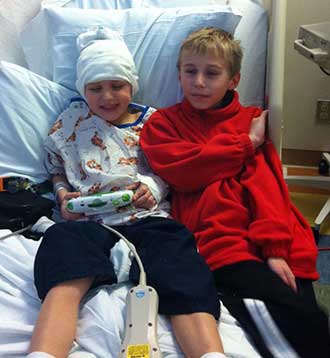
Super Bowl Sunday, 2012: The day before diagnosis, Sean and his brother Brian watched the game from Sean's hospital bed.
We consulted with many of the top neurosurgeons across the country to discuss our options. The most difficult and frustrating thing for us was that everything the doctors were telling us, and everything we learned in our own research, was that surgery is the best treatment for a brain tumor like Sean’s – but that he shouldn’t have it. Surgery could even be “curative” if the whole tumor were removed, but Sean’s tumor was very large, and it was located in and near the areas of his brain that control speech and motor functions. Removing the tumor would likely result in massive neurological injury. Surgery was the best option – it just wasn’t an option for us.
Two weeks after that first seizure we met Dr. Greenfield, who was the first doctor to give us a glimmer of hope. He told us there might be a way to safely operate on Sean’s tumor – maybe not to get the entire thing out, but at least reduce its size and get enough tissue to establish a firm diagnosis. Dr. Greenfield was cautious, and told us he’d have to do some testing first to learn where Sean’s speech and motor functions were in relation to the tumor. The results would help determine whether he could attempt surgery without injury to Sean. Although he didn’t say that surgery could definitely be done, the “maybe” he gave us felt like a lifeline. It was my birthday that day, and I had been given the best gift I could have hoped for!
The initial tests were inconclusive in isolating the location of Sean's speech and motor functions, and meanwhile his seizures were rapidly escalating. He was having as many as six grand mal seizures a day despite taking high doses of two anti-seizure medications. The epilepsy that had developed as a result of the tumor was becoming as much of a detriment to Sean as the tumor itself. We needed move as quickly as possible.
Dr. Greenfield recommended proceeding with surgery, using a two-stage approach. The first surgery would be to place intracranial grids directly on the surface of Sean's brain to precisely map the location of his speech and motor functions. If the mapping showed a “safe” way to access the tumor, then in the second procedure a week later Dr. Greenfield would remove the grids – and as much of the tumor as possible.
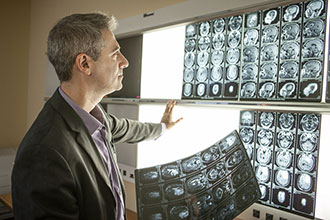
Dr. Jeffrey Greenfield
Although it was what we wanted, it was very hard for us to make that final decision to go ahead with the surgery. So many doctors had advised against it. Could Dr. Greenfield really do what he said, and get the tumor out without leaving Sean with a massive brain injury? He had such a quiet confidence about him, and we wanted so desperately to believe that he could do what he said. At the same time we kept replaying in our minds what we heard from so many other, well-respected neurosurgeons we had consulted: that operating on this tumor would most likely result in a “massive neurological deficit” for Sean. How could we possibly take this kind of risk with our perfect little boy? But we had to give him every best chance to survive!
We asked Dr. Greenfield about getting a second opinion on the results of the mapping and the “safe way in” before going ahead with the second procedure. His response to us was “Of course. I don't have any ego about this, I’m just trying to do right by Sean. You're never going to feel comfortable when your son's brain is under discussion. He's going to do fine.” This was the moment when I knew for sure that Dr. Greenfield was the right guy. We knew there were no guarantees of the outcome, but had no doubt he would do everything in his power to give us back our perfect little boy.
In the days and weeks leading up to the surgery, Dr. Greenfield assembled a “dream team” of doctors to work on Sean’s case (Dr. Theodore Schwartz, Dr. Juliann Paolicchi, and Dr. Kenneth Perrine). We met with them all and knew that we had the best of the best in Sean’s corner for this fight.
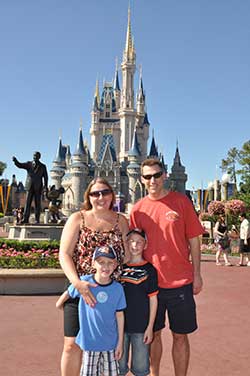
Before the big day, we went on Sean’s Make-a-Wish trip to Disney World. Not knowing whether he’d be able to speak after the surgery, we just didn’t want to wait to take this magical trip. Sean’s aunts, uncles, and cousins surprised us by meeting us there to share a few of those special days and make some memories. They say Disney World is a place where dreams come true, and that’s exactly what we were hoping and praying for!
The first surgery took four hours, and the wait for news was excruciating. But Dr. Paolicchi and Dr. Greenfield kept us posted, Sean did great, and everything went as expected. The sense of relief is simply indescribable. We could finally take a deep breath. But it had been traumatic for Sean, and he was in so much pain, with tubes and wires everywhere. On the second day, the swelling started and he looked so miserable. It was heartbreaking. The nurses that cared for him in the PICU were absolutely amazing though – angels on earth, all of them. Dr. Perrine and Dr. Paolicchi started mapping Sean's speech and motor functions using the grids that had been placed on his brain. It was three or four days before he really seemed to feel better, just in time for surgery number two.
The wait during the second surgery was so much harder because the risks were so much greater, but after about three hours Dr. Greenfield came out and gave us an update, letting us know that Sean was doing well. After another hour or so Dr. Schwartz came out to tell us they’d been able to remove 85 to 90 percent of the tumor. That was more than we possibly could have hoped for!
We went up to the PICU to wait for Sean, and Dr. Greenfield came to see us there. He told us the surgery had gone great, and now we had to wait until Sean woke up to see if he was able to talk and move his right side. That would really be the true test of how “successful” this surgery was.
When we first saw Sean as he woke up, he looked at me, put out his arms and cried “mommy” in the saddest, pained little voice. We nearly dropped to our knees with relief! He was talking and moving, and despite how bad he looked our tears of joy wouldn’t stop.
Sean’s recovery was nothing short of remarkable. Although he was exhausted, unhappy, and in pain once again, the worst of the trauma to his little head had really occurred with the first procedure. Just a day and a half after the second surgery Sean was feeling good enough to get out of bed and take a walk around the pediatric floor with us, and he was discharged straight from the PICU three days later. We even went out for ice cream that night to celebrate finally being home!
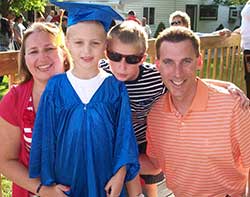
Sean was really tired at first, but within a few weeks he started feeling better. He was even able to attend his pre-school “graduation” in June – there wasn’t a dry eye in the place when he walked across the stage with a big smile, bald head, and giant scar. For the rest of the summer we found Sean still got fatigued easily, but other than that he was pretty much back to his old self again. In July, he was back at pre-school full-time, doing almost everything that his friends were able to do.
Sean does face some challenges and delays when it comes to memory, processing language, and fine motor skills on his right side. We’ll never know whether these are a result of the tumor, the months of seizures, or the surgeries, but it really doesn’t matter. He gets speech and occupational therapy twice a week, and he’s getting extra help at school – but he was able to start kindergarten with his friends, and that’s such a big thing.
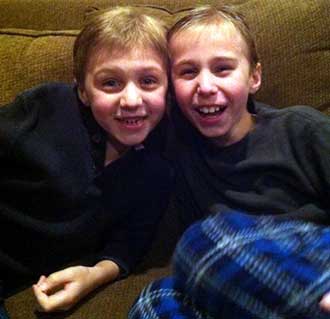
Super Bowl Sunday, 2013: Sean and Brian, a year later
I wouldn’t say we are confident yet about his health and recovery, although we are much more optimistic than we were when he was first diagnosed. Dr. Greenfield had to leave behind a portion of Sean’s tumor, so that is obviously worrisome for us. Sean now goes for MRI surveillance every three months. He has had three MRI’s since surgery, and all three showed that his tumor remains stable (no signs of new or progressive disease). Now we just have to get through 100 more. It’s possible that Sean’s tumor will never grow again, but he’s only five years old. We have a lot of years ahead to hope and pray that it doesn’t grow, or doesn’t start causing Sean to have seizures again. We live in constant fear of those two possibilities, which would put us right back in that impossible place where we were when he was first diagnosed.
We have met other parents of kids with brain tumors, and let me tell you that’s one tough “club” to be in. There are some success stories, but just not enough. Our hope is that Sean’s can be one of those stories with a happy ending, that he can give a glimmer hope to another family out there that this is facing this awful diagnosis.
Today and every day we are in awe of Sean. Seeing what he endured, watching him go through it with such bravery and strength, and an ability to smile through anything, we couldn’t be more proud of him. To see him running around and laughing today, you would never guess what he has been through this past year, or know that he is carrying a ticking time bomb in his head. He is simply an amazing little boy.

Before this happened, like any family we loved our kids and enjoyed spending time together, but we also found ourselves getting caught up in day-to-day life: work, household chores, schoolwork. We learned very quickly to not take one minute of life for granted, that every day truly is a gift. There is no more sweating the small stuff. We’ll leave the dishes in the sink after dinner in order to cuddle on the couch and read a book with the boys. We know what a miracle it is to hear them laughing and playing together. We treasure every word Sean says, whether he’s talking about his day at school, what he did with his friends, or when he says “I love you.” To think that it all could have been taken away from us, that we might not have heard any of that from him again following surgery…. We are grateful to Dr. Greenfield for every single word, every smile, every laugh!
From the first time we met with him, we could tell that Dr. Greenfield wanted the very best for Sean. That first day in his office, when he talked to us about finding a way to get at this tumor, he said his goal was to find a safe way to operate so that Sean could be healthy and live to be 90. Really? Did he just say that? At that point it had only been 10 days since Sean’s fateful MRI, but already we were tired of talking about his survival in the short term. Hearing doctors tell us there was an 80 percent chance he’d be alive in five years just wasn’t good enough. Finally, here was someone who was actually willing to talk about the same long-term survival goals for Sean that we had. We absolutely trusted Dr. Greenfield and his dream team, and we knew in our hearts that no matter what, he would do the very best for Sean.
******************************
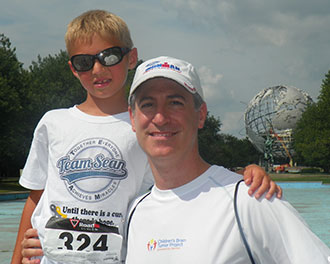
Update: On July 27, 2013 Sean appeared as a Weill Cornell Pediatric Brain and Spine Center Ambassador at the second annual Miles for Hope "Moving Towards a Cure" event in historic Flushing Meadows Park. Both Brenda and Sean spoke at the event. Watch Video
Read more stories about brain tumor patients
Find out more about Brain Tumors in Children